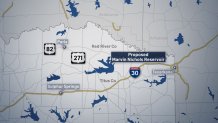Several North Texas cities are stepping up water conservation rules this week as the heat wave boosts drought conditions.
Coppell increased to stage two restrictions allowing irrigation only on certain days. DeSoto imposed that city's stage one restrictions. Most residents of North Texas cities are asked not to irrigate lawns during the middle of the day.
At the same time, future water supplies for North Texas are a topic of debate including a proposed Marvin Nichols Reservoir in far Northeast Texas, 150 miles from Dallas.
The project has been a part of state water plans for many years with fierce opposition from neighbors and some environmental groups.
Get DFW local news, weather forecasts and entertainment stories to your inbox. Sign up for NBC DFW newsletters.
“There are many options for water supply that avoid the destruction and the huge economic cost of building a reservoir the size of Marvin Nichols Resrvoir,” said Janice Bezanson with the Texas Conservation Alliance.
She cites the Toledo Bend Reservoir on the Texas-Louisiana border and Lake Texoma on the Oklahoma border as existing lakes that could provide water to North Texas.

Bezanson half of the water currently provided to North Texas is used outdoors.
Local
The latest news from around North Texas.
“What we need to be doing is conserving in our lawn watering practices,” she said.
Water that goes down the drain indoors could be reused with much higher treatment standards as happens in some other places.
One example of wasted water from leaky Texas water infrastructure was discovered in the Great Trinity Forest in Dallas, where a large water pipeline leaking for several years caused a swamp.
A $1 billion water fund that would help fix leaks and outdated systems around the state goes before voters in November.
“Nobody is saying that that alone is enough for future water supply. We will need some future water supplies,” Bezanson said.
Some new supplies are already on tap.
The dam is finished and Bois d’Arc Lake is filling up in Fannin County. It’s not open for recreation yet but is supplying drinking water through new pipes to the North Texas Municipal Water District.
The new Lake Ralph Hall is also under construction in Fannin County for the Upper Trinity Regional Water District.
At 66,000 acres, Marvin Nichols would be much larger than most Texas reservoirs.
Bezanson said it would require more mitigation for the loss of habitat, which could bring the total Northeast Texas acreage lost for the project to around 200,000 acres.
“Taking 200,000 acres of productive land out of production would just be devastating to the local economy,” she said.
Marvin Nichols is still part of the state’s future water plan, but the current state budget includes money for a new study on the project.
The North Texas Municipal Water District is one of the entities that would receive water from Marvin Nichols.
No one with the agency was available for an interview Monday but spokesperson Kathleen Vaught provided an email response:
"Access to reliable water supplies is critical to maintaining the quality of life and economic prosperity for all Texans. The Texas Comptroller estimated that our state’s population will increase to 47 million by 2050. The North Texas region, in particular, is seeing significant population growth and remains among the fastest growing. Robust, actionable strategies are needed to ensure that Texans will have adequate water to meet future needs and withstand future droughts. The Texas Water Development Board (TWDB) is responsible for developing the State Water Plan (SWP) to provide water for all Texans and support the growing state economy, now and in the future.
Every five years, the TWDB updates its SWP, which is developed to assess regional water supplies and needs 50 years into the future. The TWDB compiles information from 16 regional water plans to develop the SWP. The North Texas Region, including NTMWD’s service area, lies within the Region C water planning area. The 2021 Region C plan recommends numerous strategies to meet the future water supply needs of North Texas. Water conservation and reuse strategies are a cornerstone of both the Region C and State Water Plans. Water conservation and water reuse are foundational for Region C’s and NTMWD’s water future. NTMWD already makes use of significant quantities of reused water and pursues water conservation aggressively within our service area and through partnerships in the region. While there are a number of conservation strategies included in the SWP for reducing water demands and making efficient use of existing supplies, it is clear that the development of new water supplies is required to meet the future needs of Texas.
With the ongoing rapid population growth, NTMWD continues to evaluate a number of water supply strategies identified in the Region C plan and take measures to meet the water needs of North Texans. NTMWD will continue to act responsibly and prudently in all efforts to evaluate and develop needed water supply projects for our region and Texas – our future depends upon it."



